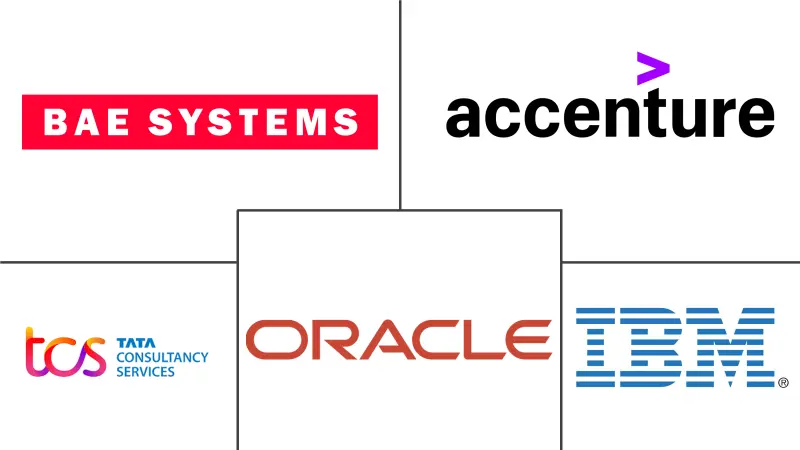System Integration Market Size and Share
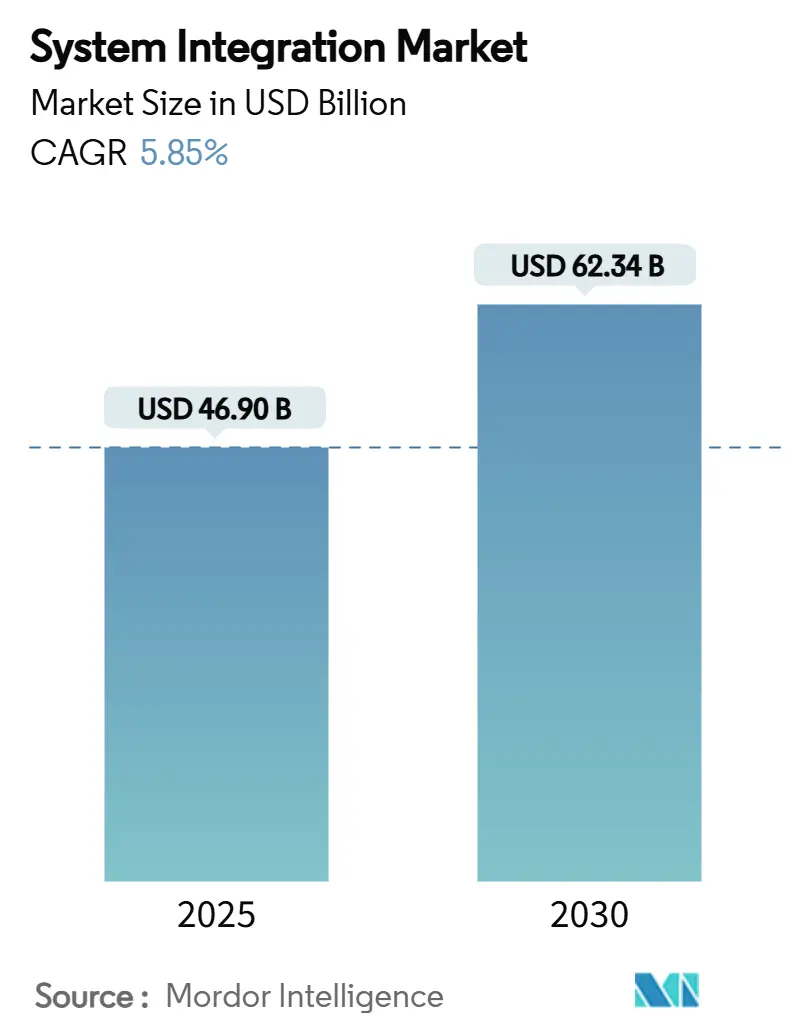
System Integration Market Analysis by Mordor Intelligence
The system integration market generated USD 46.91 billion in 2025 and is set to expand to USD 62.34 billion by 2030, advancing at a 5.85% CAGR. Momentum comes from enterprises standardizing on hybrid-multi-cloud architectures, deploying 5G-enabled edge nodes, and adopting AI-driven integration-platform-as-code tools that shrink project timelines. Growth is reinforced by healthy corporate spending: Accenture reported USD 17.7 billion Q1 FY2025 revenue and USD 18.7 billion in new bookings, while ServiceNow unveiled its AI Control Tower to orchestrate enterprise agents, showing integrators’ shift toward AI-centric operating models. North America retains scale leadership, yet Asia-Pacific’s policy-backed digital programs fuel the fastest uptake. Across service lines, application and software integration still holds the largest revenue pool, whereas infrastructure integration grows quickest on the back of cloud-native and edge build-outs.
Key Report Takeaways
- By service type, application and software integration led with 45.7% revenue share in 2024; infrastructure integration is projected to grow at a 5.9% CAGR to 2030.
- By deployment mode, on-premise held 72.3% of the system integration market share in 2024, while cloud deployment is poised for a 7.2% CAGR through 2030.
- By end-user industry, IT & telecom commanded 34.3% revenue in 2024; BFSI is forecast to register the highest 6.3% CAGR to 2030.
- By integration type, data integration accounted for 34.7% of the system integration market size in 2024 and application/API integration will accelerate at a 6.1% CAGR to 2030.
- By organization size, large enterprises held 63.2% share of the system integration market size in 2024; SMEs are advancing at a 6.9% CAGR through 2030.
- By geography, North America captured 34.2% revenue in 2024, whereas Asia-Pacific is projected to expand at a 7.3% CAGR to 2030.
Global System Integration Market Trends and Insights
Shift to Hybrid-Multi-Cloud Integration Architectures
The accelerated move toward hybrid-multi-cloud designs represents the most consequential architectural change since the first enterprise cloud migrations. Workload repatriation plans now involve 83% of large enterprises, up from 43% in 2020, as finance chiefs stress opaque billing and unused capacity. Forty-two percent of companies report difficulty forecasting cloud spend while 82% waste at least 10% of budgets, spurring demand for integration layers that unify cost governance and security across heterogeneous estates.[1]Digitalisation World, “Cloud Cost Report 2024,” digitalisationworld.com New platforms deliver policy-driven orchestration, automated lineage tracking, and data-residency enforcement, elevating system integration market relevance across regulated industries.
5G and Edge-Computing Roll-outs Demanding Low-Latency Orchestration
Nationwide 5G backbones and industrial edge nodes multiply data touchpoints that need millisecond-grade responsiveness. Australia’s National Broadband Network selected Infinera’s GX Series and ICE-X pluggables to upgrade capacity, proving the importance of carrier-grade integration for converged optical and packet domains.[2]Infinera Corporation, “NBN Co Selects Infinera’s GX Series,” infinera.comManufacturers deploying closed-loop quality control route AI inference to on-premise GPU clusters, forcing integrators to mesh cellular, Wi-Fi 6, and time-sensitive networking in the same topology. The system integration market therefore benefits from long-cycle infrastructure programs that require orchestration beyond traditional data-center boundaries.
Rapid IT-OT Convergence in Smart Manufacturing
Smart-factory rollouts merge ERP, MES, and IoT telemetry in real time. Rockwell Automation’s 2024 survey shows 83% of global plants planning generative-AI pilots and 95% evaluating smart-manufacturing suites. Integrators now embed zero-trust security, digital twins, and predictive maintenance pipelines in brownfield lines. As operational networks expose previously air-gapped equipment, secure gateways and OT-aware API layers become mandatory, turbo-charging the system integration market in automotive, semiconductor, and food-processing clusters.
AI-Driven Integration-Platform-as-Code Reducing Time-to-Value
Low-code agents, pre-built connectors, and AI-generated mapping slashed project cycles from quarters to weeks. Workato’s Agentic Orchestration and n8n’s hybrid code-plus-visual model exemplify how platform-as-code substitutes dozens of manual tasks with policy libraries and regression bots.[3]Workato, “Agentic Orchestration Whitepaper,” workato.com Acceleration lets line-of-business teams iterate rapidly, making integration a continuous process rather than a one-off milestone, and enlarging the addressable system integration market beyond traditional IT shops.
Segment Analysis
By Service Type: Infrastructure Integration Gains Momentum
Infrastructure integration generated meaningful upside even though application and software integration secured 45.7% 2024 revenue. Enterprises pursuing edge clouds, zero-touch SD-WAN, and container orchestration are routing budget to infrastructure projects that bind on-premise data centers with multiple public-cloud zones. The system integration market size for infrastructure lines is projected to compound at 5.9% to 2030, outpacing legacy middleware engagements.
Heightened network complexity drives demand for observability stacks, infrastructure-as-code pipelines, and compliance gateways that operate consistently across LAN, WAN, and cloud overlays. Consulting and advisory services remain essential yet smaller in value as templated reference architectures compress billable-hours intensity. Vendors differentiate by bundling infrastructure integration with managed services that guarantee SLA adherence, positioning themselves for annuity revenue in the system integration market.
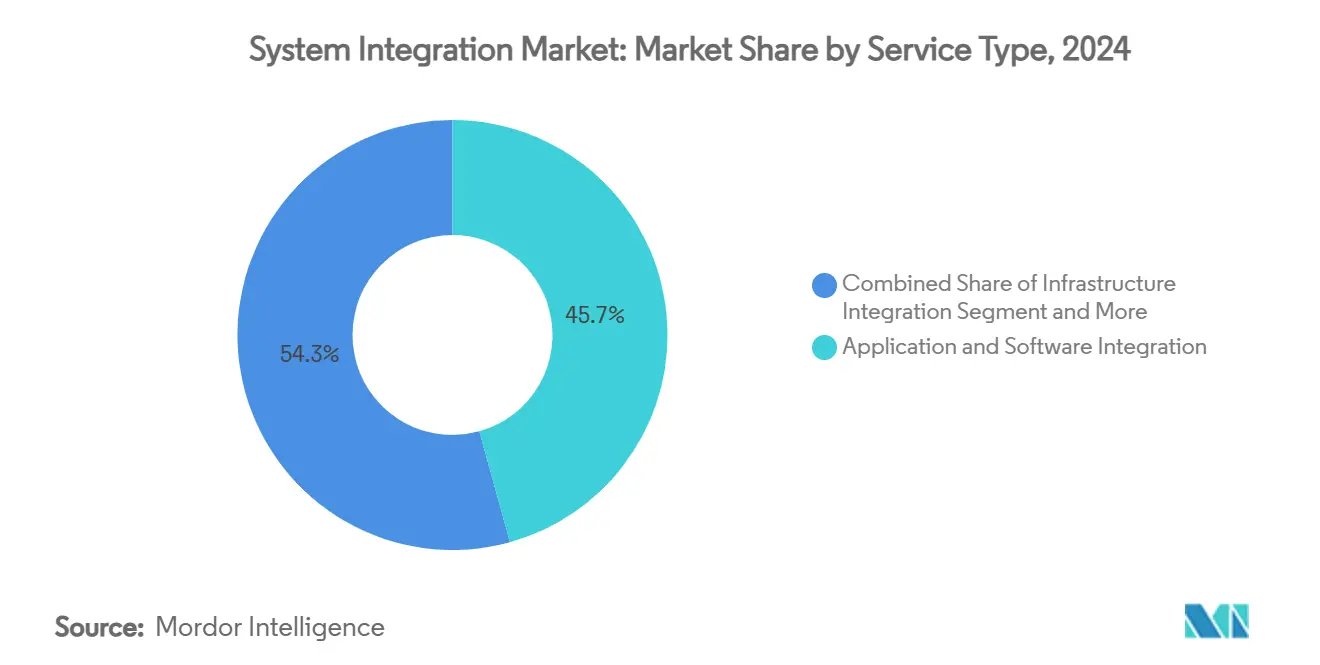
Note: Segment shares of all individual segments available upon report purchase
By Deployment Mode: Cloud Adoption Scales Under Guardrails
On-premise estates held 72.3% 2024 revenue, mainly in BFSI, healthcare, and defense where sovereign data controls trump elasticity. Yet the cloud deployment cohort will rise at 7.2% CAGR as encryption, confidential compute, and zero-trust blueprints mature. The system integration market share for subscription-based cloud integration platforms widens fastest in Asia-Pacific state projects that embrace scale-up economics.
Public cloud integration dominates greenfield digital programs such as Singapore’s USD 73 million Virtual Singapore 3D twin, whereas private cloud satisfies hybrid mandates where latency or residency restrictions persist. System integrators craft landing-zone accelerators, FinOps guardrails, and automated pipeline bootstraps to compress time-to-production, broadening adoption beyond tech-savvy early movers.
By End-user Industry: Financial Services Escalates Modernization
IT and telecom generated 34.3% spending in 2024, leveraging native capabilities to modernize core stacks early. The system integration market size attached to BFSI workloads will nonetheless climb fastest at 6.3% CAGR as banks overhaul core platforms for real-time payments, composable lending, and AI-powered risk scoring. Axis Bank’s Neo for Corporates integration with Finacle highlights the micro-services shift inside treasury workflows.
Healthcare and life-sciences investments intensify around HL7 FHIR gateways and AI-triaged imaging, while manufacturing positions integration as the backbone for smart-factory loops that intersect OT equipment. Government and utilities underpin citizen service portals with open APIs, tapping the system integration industry to comply with stringent procurement and uptime mandates.
By Integration Type: APIs Redefine Connectivity
Data integration accounted for 34.7% 2024 turnover, reflecting its foundational role in analytics and governance. Application/API integration will accelerate at a 6.1% CAGR behind micro-services, event streaming, and productized APIs that monetize back-office assets. The system integration market share for API gateways scales as enterprises embed versioning, throttling, and security into every digital product release.
Process/workflow integration keeps steady traction as business lines automate cross-system tasks to limit swivel-chair operations. Device/IoT integration expands cautiously, held back by fragmented protocols and cyber-physical safety certifications, yet represents future upside as smart-city and industrial-automation budgets converge.
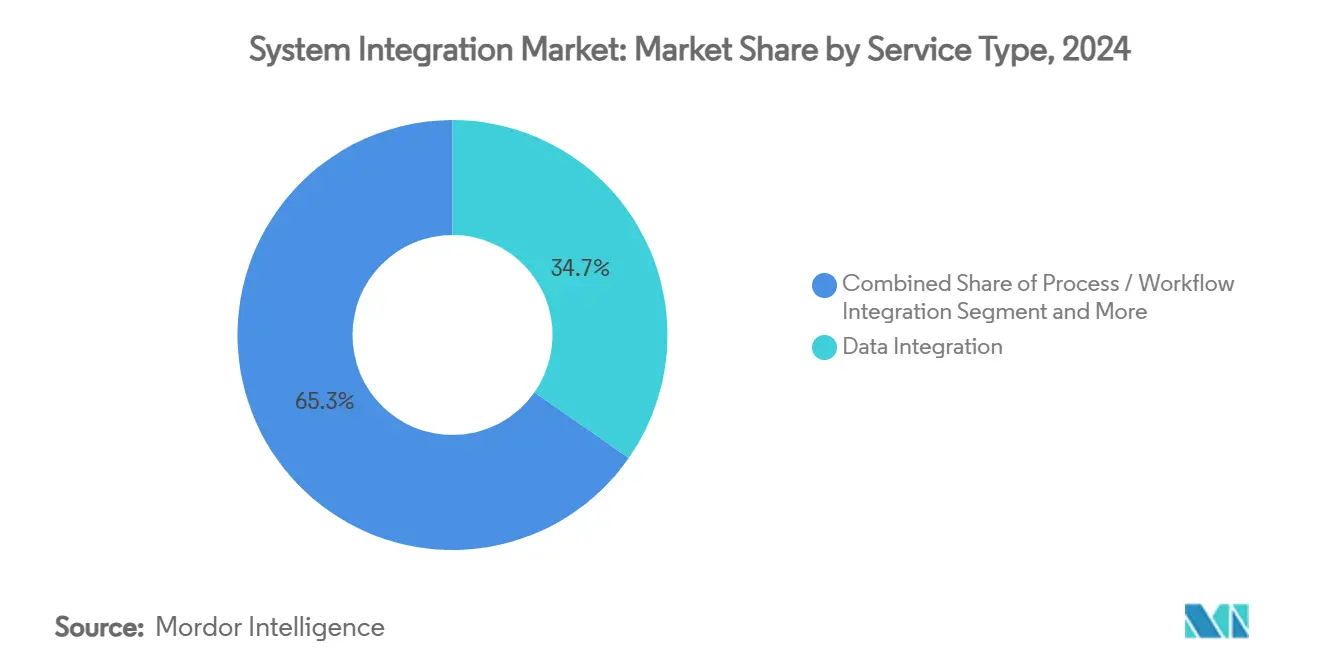
Note: Segment shares of all individual segments available upon report purchase
By Organization Size: SMEs Unlock Enterprise-Grade Tools
Large enterprises captured 63.2% revenue in 2024 and remain system integration market anchor clients through multi-year transformation contracts. Small and medium enterprises post the sharpest 6.9% CAGR as no-code orchestration, consumption-based pricing, and pre-built connectors erode historical entry barriers.
Cloud-native iPaaS offerings bundle templates, API catalogs, and AI mapping engines that non-specialists can deploy without dedicated DevOps teams. For large enterprises, meanwhile, value shifts to complex multi-vendor governance, site-reliability engineering, and compliance automation layered atop foundational integration stacks.
Geography Analysis
North America contributed 34.2% 2024 revenue, reflecting deep enterprise IT budgets, mature partner ecosystems, and early adoption of AI-driven platforms. TD Synnex notes 86% of regional clients have successfully commercialized AI projects versus 77% worldwide, validating demand for full-stack orchestration services. Federal and state bodies sponsor broadband and semiconductor incentives that further scale integration opportunities. Venture-backed startups often pilot cutting-edge practices, creating spill-over consulting business for incumbents in the system integration market.
Asia-Pacific is the fastest-growing territory at 7.3% CAGR to 2030. India’s DIGIT municipal platform powers more than 1,000 urban local bodies today and targets 4,300 under the National Urban Digital Mission, underscoring state-scale workloads entrusted to integrators. Japan’s Society 5.0 blends robotics, AI, and data spaces to modernize aging infrastructure, while Southeast Asian telcos lay 5G edge networks that need end-to-end management. Cloud-first small businesses proliferate, propelling demand for subscription-based integration suites across the region.
Europe maintains steady expansion underpinned by regulatory imperatives such as NIS2 cybersecurity rules and updated GDPR enforcement. Germany’s GAIA-X fosters a federated cloud that preserves data sovereignty while promoting interoperability, contributing recurring opportunities for integrators versed in sovereign cloud architectures. Pan-Nordic e-invoicing rollouts and cross-border real-time payment rails require harmonized APIs and message mapping, boosting demand for certified vendors in the system integration market.
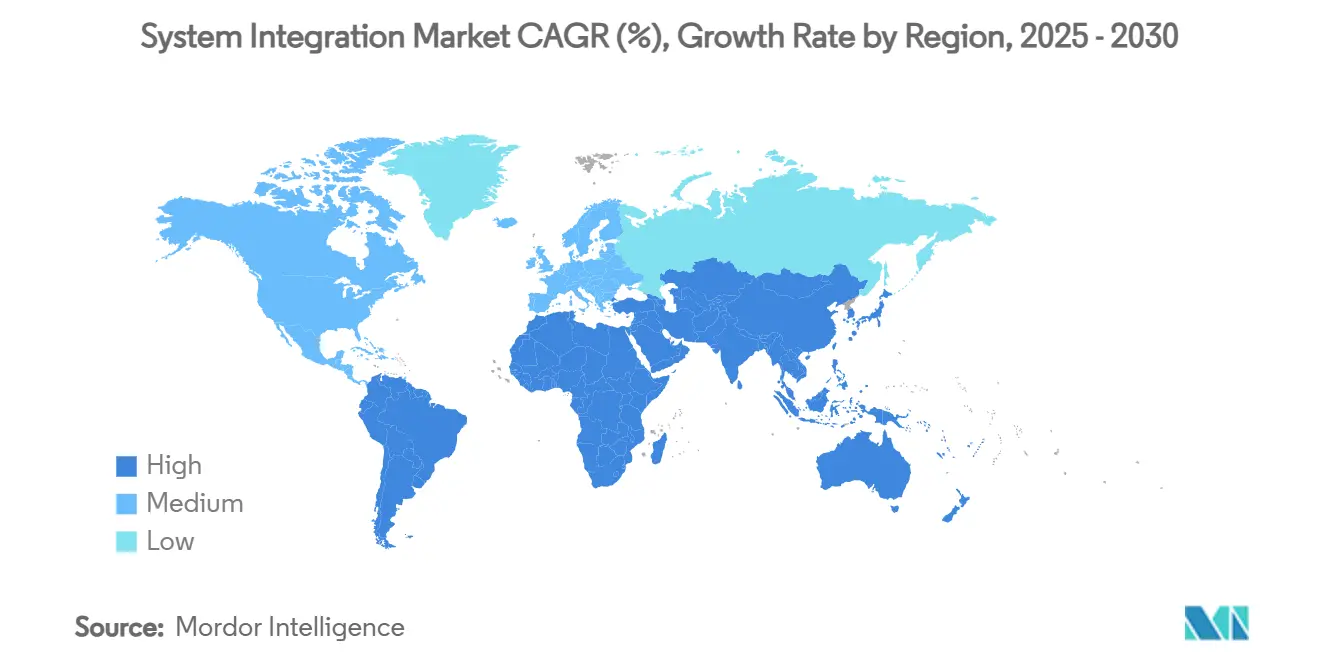
Competitive Landscape
The system integration market exhibits moderate concentration. Accenture, IBM Consulting, and Tata Consultancy Services leverage global delivery networks, deep industry templates, and sustained R&D spend to anchor multi-year programs. Accenture closed FY2024 at USD 67.2 billion revenue and disclosed a USD 450 million generative-AI pipeline, signalling aggressive positioning in platform-driven orchestration. IBM announced USD 6 billion AI-related signings and bundles watsonx with integration accelerators to defend share against cloud-native entrants.
Competition intensifies as hyperscalers offer integration PaaS stacks that abstract infrastructure and expose serverless connectors, while low-code vendors embed AI copilots that auto-generate mappings. Traditional integrators reply with acquisitions CGI absorbed Apside to add 2,500 specialists in Europe and joint ventures that combine sector know-how with SaaS ecosystems. Intellectual-property-led offerings, such as reference frameworks for regulated industries, become decisive differentiators as price-only models erode.
White-space growth resides in edge-computing orchestration, data-sovereignty compliances, and industry-specific ESG automation. Integrators that certify blueprints for zero-trust OT networks or deliver turnkey AI agent governance can tap incremental budgets. Conversely, talent scarcity and vendor-lock-in fears pressure margins, requiring automation of discovery, testing, and documentation to sustain profitability across the system integration industry.
System Integration Industry Leaders
-
Accenture
-
IBM Corporation
-
Tata Consultancy Services Limited
-
Oracle Corporation
-
BAE systems
- *Disclaimer: Major Players sorted in no particular order
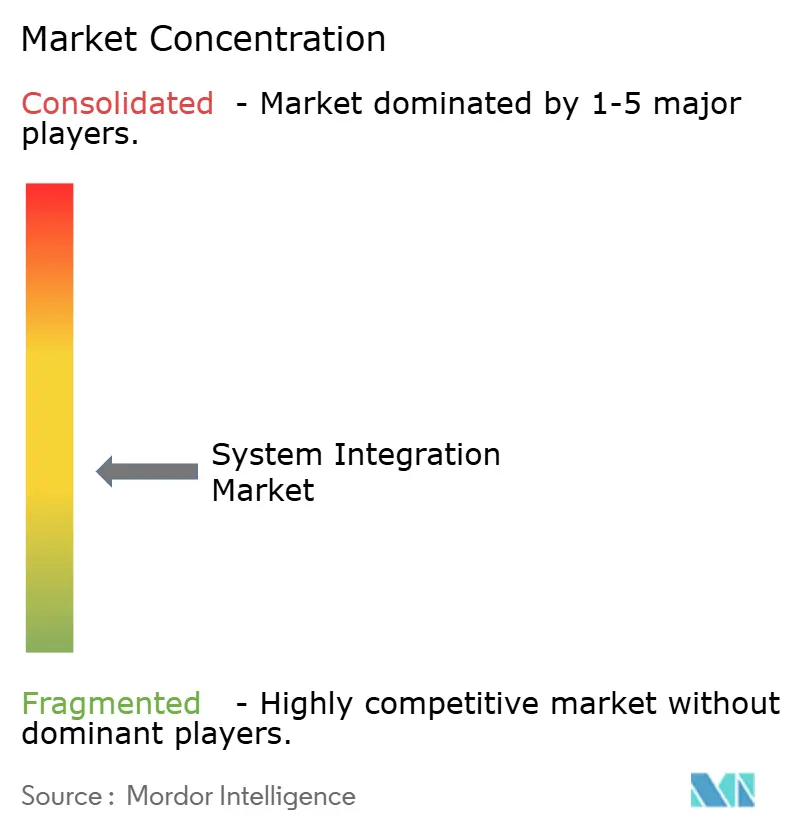
Recent Industry Developments
- January 2025: ServiceNow launched AI Control Tower at Knowledge 2025, providing centralized management of enterprise AI agents with Accenture, Adobe, and Google Cloud partnerships.
- December 2024: Accenture reported Q1 FY2025 revenues of USD 17.7 billion with 8% growth and USD 18.7 billion in new bookings.
- March 2024: Australia’s National Broadband Network chose Infinera’s GX Series Platform and ICE-X pluggables for nationwide upgrade.
- February 2024: Nokia completed USD 2.3 billion acquisition of Infinera to expand optical networking portfolio.
Global System Integration Market Report Scope
System integration connects different subsystems into a single, more extensive system that functions as one. Regarding software solutions, system integration is typically defined as linking several IT systems, services, and Software to enable them to work functionally. Organizations use system integration to improve the productivity and quality of their operations.
The system integration market is segmented by service type (infrastructure integration, software/application integration, consulting), by end-user industry (automotive, aerospace, and defense, IT and telecom, BFSI, healthcare, oil, and gas), and by geography (North America [United States, Canda], Europe [Germany, France, United Kingdom, Rest of Europe], Asia Pacific [India, China, Japan, Rest of Asia Pacific], Rest of the World). The market sizes and forecasts are provided in terms of value (USD) for all the above segments.
| Infrastructure Integration |
| Application and Software Integration |
| Consulting and Advisory |
| On-Premise |
| Cloud (Public and Private) |
| IT and Telecom |
| BFSI |
| Healthcare and Life Sciences |
| Manufacturing |
| Government and Utilities |
| Energy and Oil and Gas |
| Retail and E-commerce |
| Aerospace and Defense |
| Automotive |
| Others |
| Data Integration |
| Process / Workflow Integration |
| Application / API Integration |
| Device / IoT Integration |
| Large Enterprises |
| Small and Medium Enterprises |
| North America | United States | |
| Canada | ||
| Mexico | ||
| South America | Brazil | |
| Argentina | ||
| Rest of South America | ||
| Europe | Germany | |
| United Kingdom | ||
| France | ||
| Italy | ||
| Spain | ||
| Rest of Europe | ||
| Asia-Pacific | China | |
| Japan | ||
| India | ||
| South Korea | ||
| Southeast Asia | ||
| Rest of Asia-Pacific | ||
| Middle East and Africa | Middle East | Saudi Arabia |
| United Arab Emirates | ||
| Turkey | ||
| Rest of Middle East | ||
| Africa | South Africa | |
| Nigeria | ||
| Egypt | ||
| Rest of Africa | ||
| By Service Type | Infrastructure Integration | ||
| Application and Software Integration | |||
| Consulting and Advisory | |||
| By Deployment Mode | On-Premise | ||
| Cloud (Public and Private) | |||
| By End-user Industry | IT and Telecom | ||
| BFSI | |||
| Healthcare and Life Sciences | |||
| Manufacturing | |||
| Government and Utilities | |||
| Energy and Oil and Gas | |||
| Retail and E-commerce | |||
| Aerospace and Defense | |||
| Automotive | |||
| Others | |||
| By Integration Type | Data Integration | ||
| Process / Workflow Integration | |||
| Application / API Integration | |||
| Device / IoT Integration | |||
| By Organization Size | Large Enterprises | ||
| Small and Medium Enterprises | |||
| By Geography | North America | United States | |
| Canada | |||
| Mexico | |||
| South America | Brazil | ||
| Argentina | |||
| Rest of South America | |||
| Europe | Germany | ||
| United Kingdom | |||
| France | |||
| Italy | |||
| Spain | |||
| Rest of Europe | |||
| Asia-Pacific | China | ||
| Japan | |||
| India | |||
| South Korea | |||
| Southeast Asia | |||
| Rest of Asia-Pacific | |||
| Middle East and Africa | Middle East | Saudi Arabia | |
| United Arab Emirates | |||
| Turkey | |||
| Rest of Middle East | |||
| Africa | South Africa | ||
| Nigeria | |||
| Egypt | |||
| Rest of Africa | |||
Key Questions Answered in the Report
What is the current size of the system integration market?
The system integration market generated USD 46.91 billion in 2025 and is forecast to reach USD 62.34 billion by 2030 at a 5.85% CAGR.
Which region is growing fastest in the system integration market?
Asia-Pacific is projected to grow at 7.3% CAGR to 2030 because government-backed digital-infrastructure programs are scaling multi-cloud and edge deployments.
Which service segment leads revenue today?
Application and software integration holds the largest 45.7% revenue share, reflecting ongoing modernization of legacy stacks.
Why is BFSI considered a high-growth end-user segment?
Banks and insurers are accelerating core-platform modernization and real-time risk analytics, pushing BFSI to a 6.3% CAGR through 2030.
How are AI platforms influencing integration projects?
AI-driven integration-platform-as-code tools automate mapping, testing, and deployment, reducing delivery cycles from months to weeks and expanding addressable use cases.
What is a primary challenge facing the system integration industry?
A global shortage of integration architects with expertise in multi-cloud, AI, and security threatens to slow project delivery and inflate costs.
Page last updated on:
